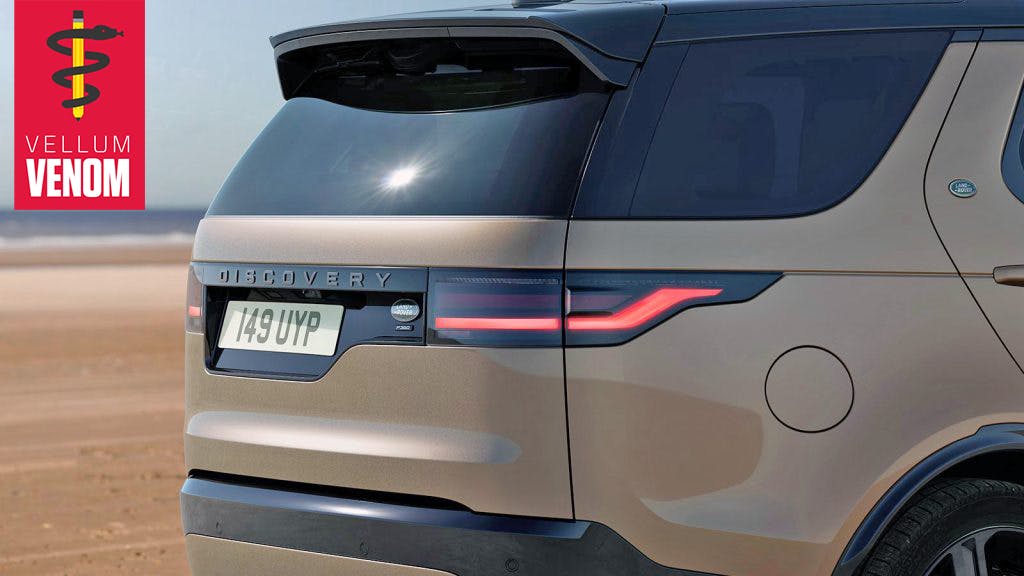Vellum Venom Vignette: Asymmetrical anxiety at the Disco?

Jeremy writes:
Hi Sajeev,
This is more of a Vellum Venom question, rather than a Piston Slap: I’d love your opinion on the current Disco (i.e. Land Rover Discovery), and why the rear end just doesn’t work. I can understand what they’re trying to do, but why does the offset numberplate work on the Disco 4, but not on the 5? Is it because the rear glass on the 4 itself is asymmetrical, so that counterbalances the offset plate location?
I thought I might get used to it, but the more I stare at it, the more wrong it looks, and I can’t put my finger on why. Anyway, would love to hear your thoughts as someone who knows a hell of a lot more about car design than me …
Sajeev answers:
Thanks for reaching out, Jeremy. As my thoughts are merely a springboard for readers to draw their own conclusions, let’s compare the asymmetry presented in the Disco 5 (above) with the Disco 4 shown below.

I’m no proponent of asymmetric design, but what made it palatable on the Disco 4 was the fact that asymmetry was present in a major body component and every panel around it was integrated accordingly. Jeremy’s notion of the glass being counterbalanced by the the tailgate release/license-plate light assembly is 100 percent spot-on.
Here’s why: Note how, on the left-hand side, the bottom of the glass starts at the top corner of the red taillamp assembly (photo below), while the bottom right-hand side ends at a point that, if you extend the line, bisects the two round brake lights (photo above). Now consider the tailgate release/license-plate light assembly, as it shares the same start/end points as the rear window.
Remember what I said about being “integrated accordingly?” Note how the right-hand lamp is sized so that the base of the tailgate release assembly coincides with the transition point between red and clear plastic. With that lighting pod working in harmony with the asymmetry, the lefthand lamp was mirrored to complete the integration.

Now you know why the Disco 4’s posterior has such a huge amount of real estate dedicated to white lamps: Asymmetry made it all possible!
My (in)ability to convey the genius of the Disco 4’s asymmetry aside, just remember some designer(s) spent a lot of time making asymmetry both logically integrated and beautiful.

That said, the Disco 4’s designers had a good blueprint: Their start/end points aren’t radically different from the original Disco’s asymmetric rear window relative to its lighting pods. Of course, the original’s use of asymmetry was purposeful, as the external spare tire needed a home.

Even the original’s Alpine lights (i.e. sunroofs above the C- and D-pillars) are given a hat-tip in the Disco 4’s roof. But much like the asymmetric glass, the look is reduced to its most basic shapes and integrated like a minimalist infinity pool in a fancy McMansion. There was also something very, very appealing about the Disco 4’s minimalist box form—à la Sub-Zero fridge—paying homage to the utilitarian nature of the original Disco.

And what of the current Disco 5? A rounded form, mysterious black roof with only a small height adjustment above the C-pillar, deleted Alpine lights in favor of a wide-angle glass roof, Mini Cooper-worthy rear window, and tacked-on asymmetry via license-plate holder do not a proper Discovery make.

Perhaps the only true travesty here is the solid black roof; when you configure a Disco 5 with a painted roof, the slight elevation change is more pronounced. That said, the rear roof glass’s extra width with the ever-so-slight bend is certainly an homage to Alpine lights. Perhaps Land Rover tried to keep the visual heritage intact, while broadening the Disco’s potential audience. Was it successful, though? Can the Disco 5 have its cake and eat it too?
The Disco 5 far from unappealing, and this generation’s rethink reminds us that heritage is difficult to implement in our hyper-globalized, cost-sensitive world. Plus, ensuring brand cohesiveness over the course of decades is close to impossible, as picky folks like us will never be happy with a manufacturer’s justification for damn near anything.
But seriously, they shoulda kept the asymmetric rear window, right?
While Vellum Venom isn’t necessarily a Q&A column, reader feedback worthy of a quick “vignette” discussion is appreciated. If you have something we should discuss, email pistonslap@hagerty.com.

